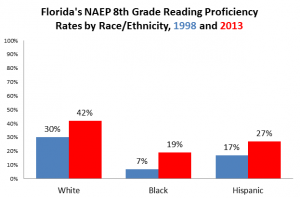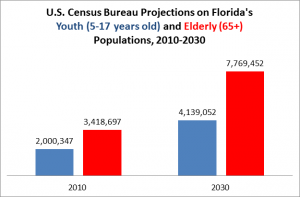The U.S. Census Bureau projects big demographic challenges ahead for Florida. The below figure summarizes its projections for the simultaneous increases in Florida’s youth and elderly populations out to the year 2030.
So let’s take the blue and the red columns separately. The blue columns show Florida’s youth population aged 5-17 is set to more than double between 2010 and 2030 – from approximately two million to well over four million. The 5-17 age cohort underestimates the scale of the challenge from a budgetary standpoint, by the way, as Florida 4-year-olds are eligible for the Voluntary Pre-K program, and many 18-year-olds are still in school.
So needless to say, Florida will be steadily adding more and more students year by year for as far as the eye can see. The current choice programs will not even begin to save Florida taxpayers the expense of building a huge number of new district schools. The time between Florida first passing a charter school law and now nearly matches the time between now and 2030 (see chart below).
 Even if Florida adopted a universal system of private school choice next year, and put a billion dollars aside for new charter school facilities for high-quality operators, it would merely slow the rate of growth for Florida school districts.
Even if Florida adopted a universal system of private school choice next year, and put a billion dollars aside for new charter school facilities for high-quality operators, it would merely slow the rate of growth for Florida school districts.
The red columns in the first figure show Florida taxpayers will be incredibly hard pressed to afford building a huge number of new school buildings. Older citizens usually have passed both their peak earning years and thus their peak taxpaying years. Elderly citizens also create demands of public dollars in the form of health care spending.
The next time Florida readers visit a mall or other public place, try to imagine 2030 by doubling the number of youngsters and more than doubling the number of elderly people you come across. If you don’t feel a growing sense of growing alarm, well bless your heart; you are just one of those completely fearless sorts.
The people tasked with paying the bills for the K-12 and higher education of young people and the medical costs of older people in 2030 include those currently enrolled in Florida public schools. Let’s use the 2013 NAEP to check in on the 8th grade reading proficiency rates of Florida’s Class of 2002 and the future Class of 2017.
 We have a lot going on in this chart, so let’s start with a few important side notes. First, this is what a good case achievement gap closing looks like. White scores have improved while the catastrophically low 1998 scores for minority students have improved faster. In 1998, a white student was more than four times as likely to score proficient than a black student, and almost twice as likely as a Hispanic student. By 2013, those ratios had improved despite the fact that white proficiency rates went up themselves.
We have a lot going on in this chart, so let’s start with a few important side notes. First, this is what a good case achievement gap closing looks like. White scores have improved while the catastrophically low 1998 scores for minority students have improved faster. In 1998, a white student was more than four times as likely to score proficient than a black student, and almost twice as likely as a Hispanic student. By 2013, those ratios had improved despite the fact that white proficiency rates went up themselves.
Next, the next time you read one of Florida’s sadly large group of education reactionaries yearning to return to the days before accountability and choice, note they are implicitly endorsing a return to the 7 percent proficiency rating that black students notched on the 1998 8th grade reading NAEP. It is pointless to hope literacy rates will improve if you are not willing to take the action required to make it a reality.
Finally (back on track), note that this pace of improvement, despite ranking very high compared to that achieved in other states, is completely, totally and utterly inadequate to prepare Florida children for the burdens they will bear as adults. Florida cannot settle for 42 percent of white students achieving full grade level reading proficiency, cannot settle for a 27 percent proficiency rate among Hispanics and should not feel anything but sickened by a 19 percent proficiency rate among black students.
My telepathic powers inform me that some of you are thinking, “But you silly policy nerd Ladner, Florida’s black and Hispanic students have proficiency ratings above the national average! You are being unreasonable; there is only so much reform the system can take.” Quoting the great Samuel L. Jackson …
I enjoy singing the praises of Florida’s considerable improvement in public education as much as anyone. This does not, however, change the fact that Florida desperately needs far more improvement as fast as possible. Many challenges lay ahead for Florida, but we can be certain they will be much easier to face with a middle-aged taxpaying public that learned how to read and do mathematics during its 13 years in the public school system.
Politics is a difficult business, and nothing is more difficult for politicians than to take their focus off of the short-term in order to deeply consider the long-term. The long-term situation in Florida looks like this: despite the improvements of the last 15 years, Florida continues to educate only a minority of students to full grade level proficiency. Florida faces a huge increase in its K-12 population dwarfed only by the even larger increase in its elderly population, placing huge strains on future state finances.
Florida does not have any time to waste. It needs to move urgently to substantially improve both the effectiveness and the cost-effectiveness of its education system.
Update: We updated the second chart to reduce the estimated growth in student population between 2010-2013 from 2 million to 1.2 million.





[…] can provide middle class incomes. And how important is that? Matthew Ladner talks about that at redefinedonline.org, except that he focuses on reading and not math. Time to get serious about math, […]
[…] The Sunshine State has seen tremendous gains in academic outcomes over the past decade as a result of the array of education reforms that have been in place, including a multitude of school choice options. Overall student achievement has increased, and gaps between white and minority children have narrowed. As education researcher Matthew Lander wrote: […]